Teff & Buckwheat Sourdough Bread | Gluten Free Pumpernickel
This teff and buckwheat sourdough bread has similar flavor and texture of a pumpernickel bread making it the most flavorful vegan gluten free sourdough sandwich bread that you can possible make. It’s a hearty vegan, gluten free loaf made with whole grain flours like buckwheat flour, teff flour, seeds and a rice flour based gluten free sourdough starter.
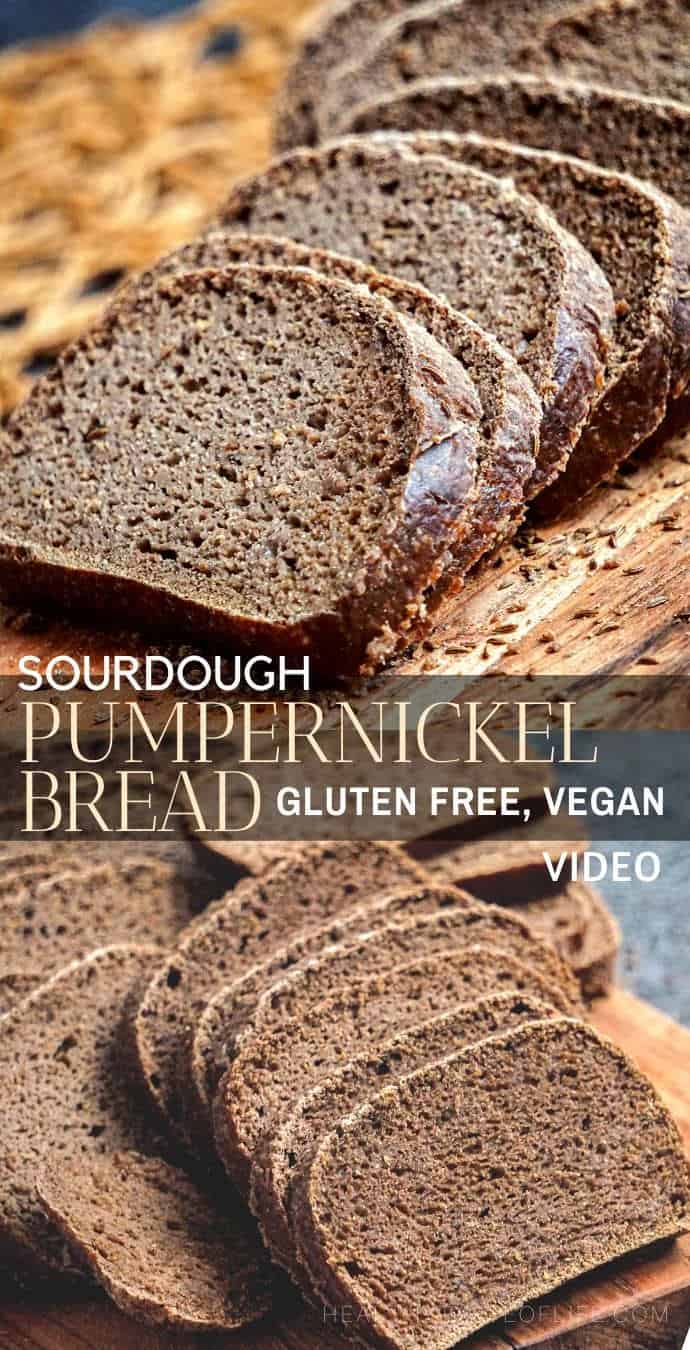
A teff sourdough bread with buckwheat flour that yields a deep brown color, sweet, “dark chocolate coffee like” flavor and earthy aroma similar to a rye based pumpernickel bread. The best part, there’s no kneading involved!
Creating A Gluten Free Buckwheat And Teff Sourdough Bread
Through my research of how to make a gluten free pumpernickel bread I found many gluten free bread recipes that use starchy flours and dark colored ingredients like cocoa to mimic the taste, but none of them were actually using a sourdough base. Which is crucial for achieving that sweet-sourness which is present in fermented rye bread.
When I developed my gluten free buckwheat bread recipe, I realized the type and quality of flours, especially when you’re gluten free baking, is another important factor. Whole grain flours like teff and buckwheat are just perfect for a gluten free pumpernickel. Their taste and color bring that missing flavor. I could’ve used only teff flour or only buckwheat flour for this recipe but I think a combination of those two ads depth of texture and flavor.
And using a gluten free sourdough starter just makes everything “click”. You get the right flavors, the right color and the right texture without using commercial yeast and starchy flours. I use the same starter for my regular gluten free sourdough bread recipe.

Buckwheat Sourdough Bread With Healthier Ingredients
Comparing to other gluten free breads this recipe is healthier because:
- It’s made with whole grain flours, like teff flour, buckwheat flour and brown rice flour incorporated in the sourdough starter.
- The incorporation of a variety of seeds like flax seeds, pumpkin seeds, sunflower seeds, coriander seeds and caraway seeds provides fiber and nutritional value to the sourdough bread;
- There are no starchy flours like potato, tapioca or corn;
- There’s no commercial yeast, no xanthan gum, no oil and no baking powder;
- This sourdough bread is gluten free, dairy free and egg free (vegan).
Pumpernickel Bread FAQs
Unfortunately, no. Rye flour (the main ingredient) contains less gluten than wheat flour but still has gluten.
The original Pumpernickel bread is usually made from only coarse rye grains, dark rye flour and sourdough starter. Since these are dense heavy ingredients, it needs a substantial amount of sourdough starter in order to rise. And the true sourdough is taking up to 24 hours to rise the bread. The traditional pumpernickel bread is also baked for 16 to 20 hours in a steam oven. In order to produce a very dark color, and a soft crust.
The closest gluten free flours that can substitute the rye flour in my opinion is teff flour and buckwheat flour.
Pumpernickel bread is a specific type of dark rye bread made with rye meal and rye flour, whereas rye bread is marketed as any bread that contains some rye flour combined with other flours.
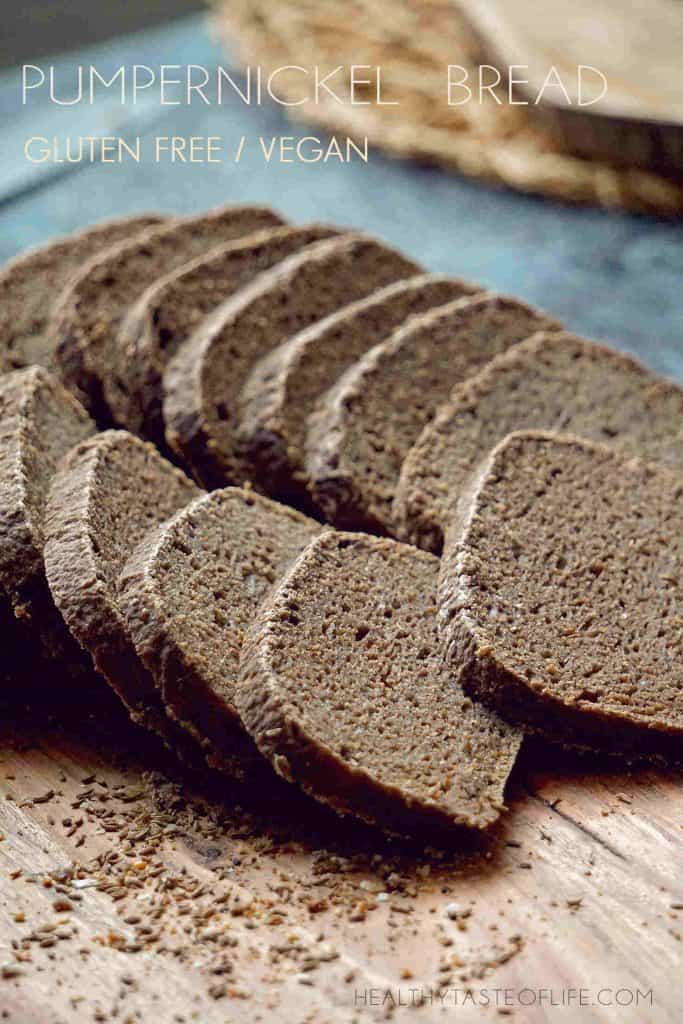
How To Make Teff And Buckwheat Sourdough Bread
Step 1. Activate The Gluten Free Sourdough Starter:
The recipe requires a gluten free sourdough starter, if you already have one, great! You’re almost set to bake. If you don’t, no worries. You can learn here how to make a sourdough starter and bread very easily.
- Once the starter is active (is bubbling regularly within a day of feeding) take the amount of starter you need (1 cup) and place it in a large bowl. The rest feed it and place it (back) in the fridge.
- Then to the gluten free starter add 1/3 cup of brown rice flour and 1/4 cup of water. Mix well. This step will activate the dormant starter that you just took out of the fridge. If your starter is thin and watery, use less water.
- Let the mixture sit in a warm (not hot) place for 3-4 hours until is light and bubbly. If it’s cold in your house – then it might take 5-6 hours.
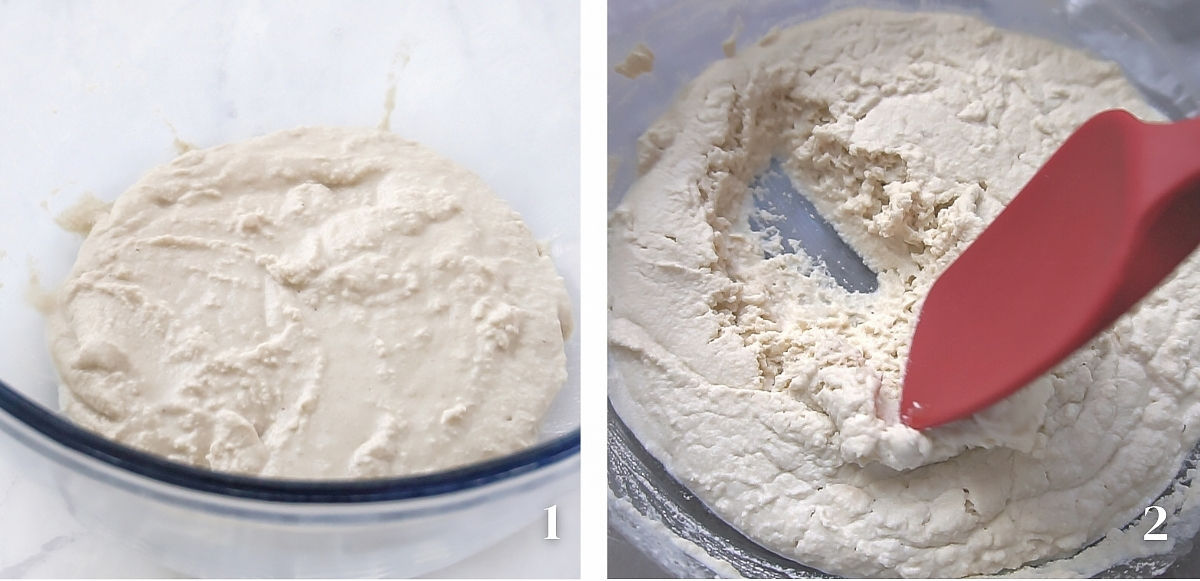
Step 2. Form The Dough:
- Once the starter is ready and active (you can see when a starter has peaked because it will have a dome-shape on top and will have air pockets inside) add the water and psyllium husk. Mix to combine. The psyllium will expand in the water, while you sift the rest of flours.
- Then to the same bowl add the flours (through a sieve). Mix everything to combine.
- The dough should look like a very thick pancake batter or like a brownie batter. No kneading is required.
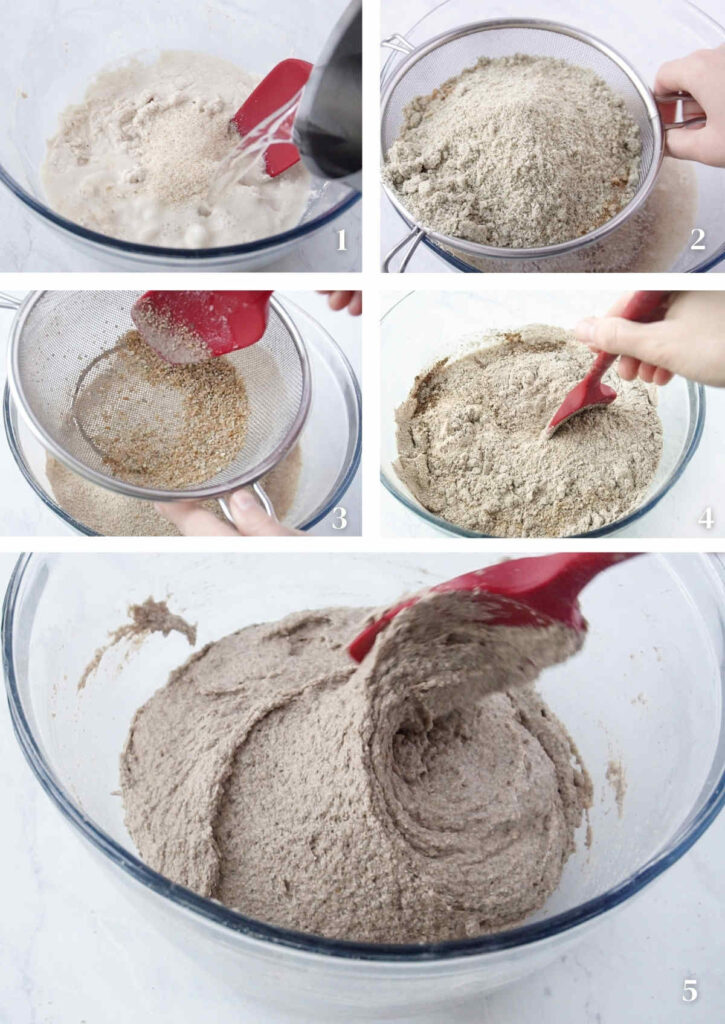
Step 3. Proofing:
- Prepare the baking pan by lining it with parchment paper, it will prevent sticking. I’m using an extendable baking tin. It has no bottom so it’s easy to remove while baking. It extends in and out easily. Scrape the dough into the pan and smooth it out.
- Cover with a plastic wrap or a towel to seal moisture and let it rise in a warm place approximately 4-5 hours (it might take an hour or two longer during winter). It depends on how warm is your kitchen. If your place is cold it might need longer than that. Once I let it sit overnight (10 hours) but it was too much, and the dough deflated.

Step 4. Bake The Bread:
- Preheat oven at 425 degrees F (220 C). Once ready to bake, remove the wrap, cover with an aluminum foil to seal moisture (without touching it), turn the temperature down to 380 F (200 C) and bake for 30 minutes.
- Then remove the foil. At this time you can also remove the baking tin (for an even baking on all sides) and bake for another 40-50 minutes until it’s not soft to the touch anymore.
- Allow to cool completely before handling or slicing! The longer the better. I usually slice it the next day and freeze it.
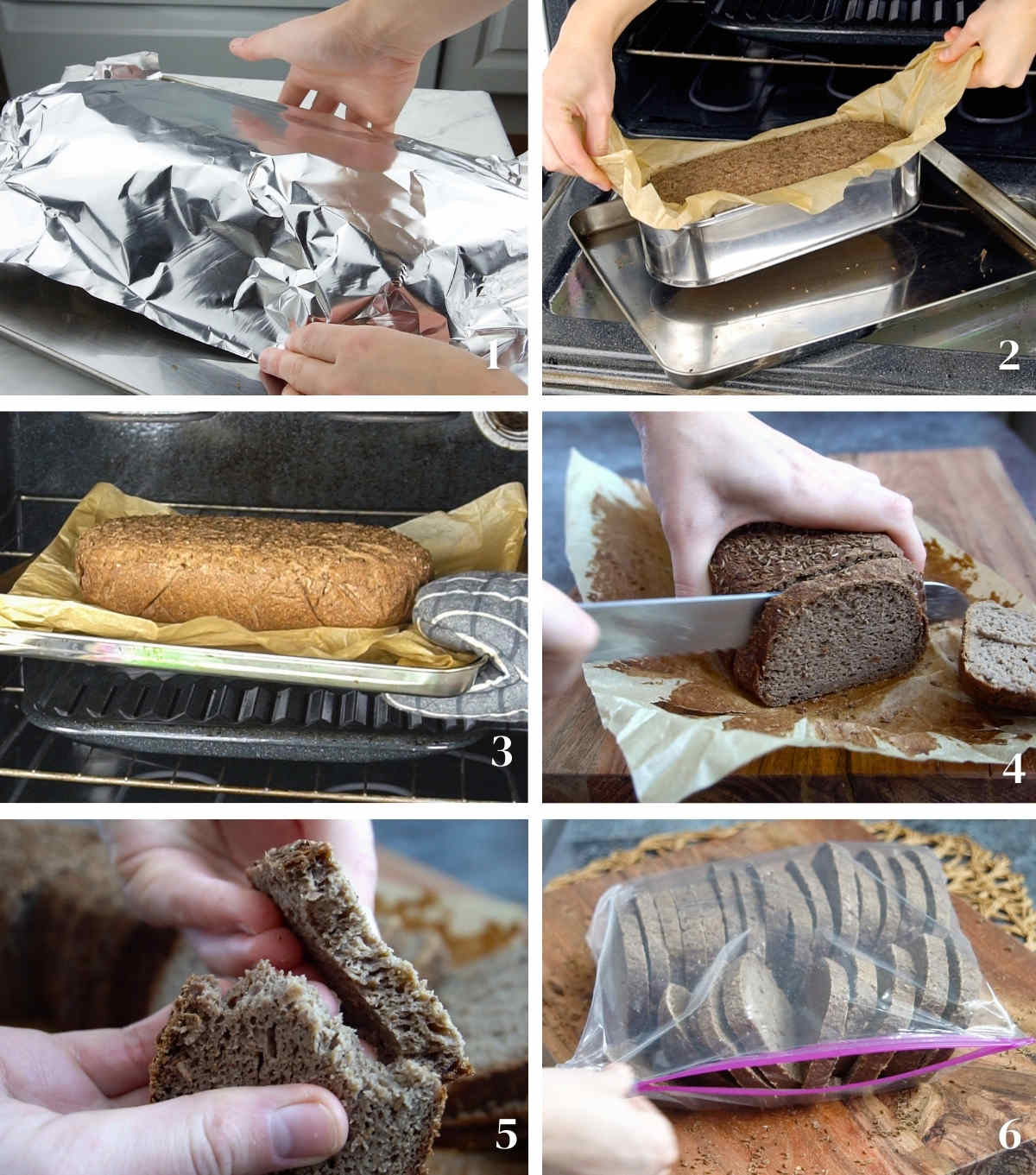
Video: How To Make Gluten Free Buckwheat Sourdough Bread
Tips For Buckwheat And Teff Sourdough Bread Recipe
- The warmer the spot the quicker the sourdough bread will rise. The ideal temperature is somewhere between 75-85 F.
- For the flours, use whole grain flours for best nutritional value.
- It’s best not to switch back and forth between brands when you first activate your starter. It’s too confusing and you won’t know where you went wrong. Also try to feed your starter with the same flour from which it’s made.
- To get that distinctive pumpernickel dark flavor and color, use caraway seeds, coriander seeds and cacao powder. I’m sensitive to cacao so I used carob powder instead, which worked fine.
- As binding agent (what usually gluten is) I used psyllium husk and flax meal. This combination provides more fiber, texture and flexibility to the final baked bread.
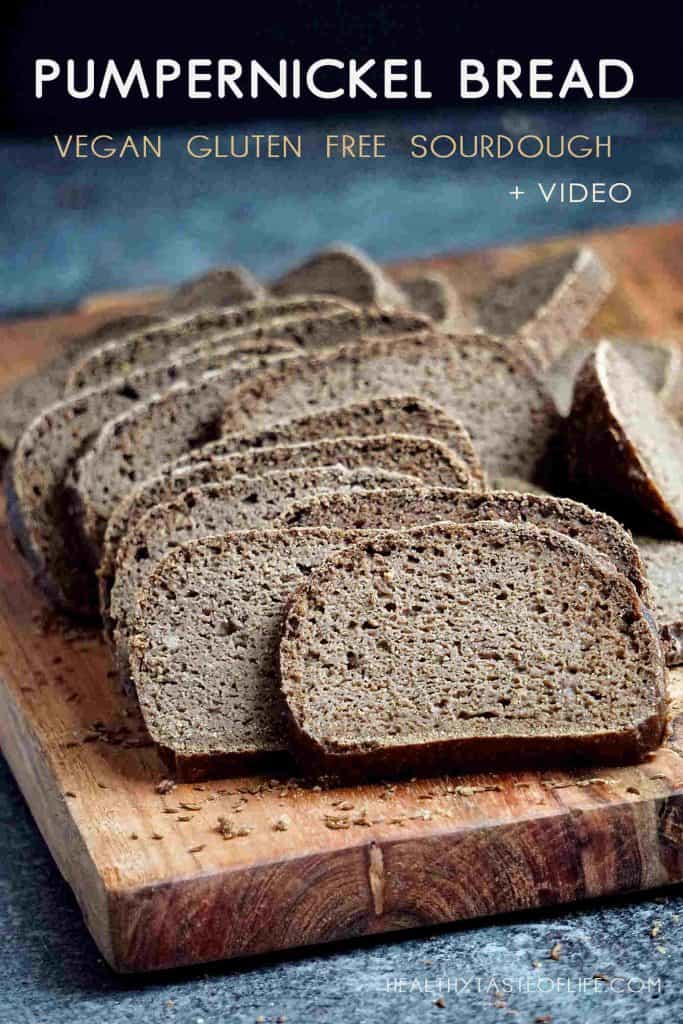
How To Store This Bread
- If you anticipate to eat the bread within 3-4 days, store it at room temperature in a sealed container.
- To store for longer periods, is best to slice the entire bread and place the slices in a plastic bag in the freezer. You can keep it for up to 4 months.
- To defrost just throw some slices in your toaster whenever you want fresh warm gluten free pumpernickel bread.
More Gluten Free Bread Recipes
- Gluten Free Sourdough Banana Bread (Eggless)
- Gluten Free Sourdough White Bread, Yeast Free, Gum Free
- Gluten Free Sourdough Buns (Vegan)
- Sourdough Gluten Free English Muffins, Vegan
- Buckwheat Bread (GF, DF)
If you made this sourdough buckwheat bread with teff flour, then please leave a star rating or a comment below the recipe card.
Your feedback is really helpful for me and readers!
For more gluten free vegan sourdough bread recipes check out my cookbook.
Teff & Buckwheat Sourdough Bread | Gluten Free Pumpernickel Bread Recipe
Ingredients
For Sourdough Starter Activation
- 1 cup gluten free sourdough starter - (previously made and refrigerated)
- ⅓ cup brown rice flour
- ¼ cup filtered water - (add 1 to 2 tbsp more if it's too thick)
For The Dough:
- 1½ cup buckwheat flour
- ⅔ cup teff flour
- ½ cup flax meal - (ground golden flax seeds)
- 2 tbsp sunflower seeds - (ground like flour)
- 2 tbsp pumpkin seeds - (ground like flour)
- 2 tbsp psyllium husk - not powder
- 2 tbsp caraway seeds - (ground like flour)
- 1 tbsp coriander seeds - (ground like flour)
- 2 tbsp maple sugar - or coconut sugar
- 1½ tbsp pink Himalayan salt - or 1.5 tsp sea salt
- 2½ cups filtered water - (+2 or 3 tbsp more if it's too thick)
- 2 tbsp cacao powder - (optional – for a more dark color) or carob powder
Instructions
- Prepare all the seeds and grind them with an electric coffee grinder.
Step 1. Activate The Gluten Free Sourdough Starter:
- If you just bought your dehydrated gluten free sourdough starter, then read the instructions on how to activate in the booklet that comes with it. If you don't have a starter, read how to make your own in this post.Once the starter is active (is bubbling regularly within a day of feeding) take the amount of starter you need (1 cup) and place it in a large bowl. The rest feed it and place it (back) in the fridge.
- Then to the gluten free starter add 1/3 cup of brown rice flour and 1/4 cup of water. Mix well. This step will activate the cold dormant starter that you just took out of the fridge.
- If your starter is thin and watery, use less water. Let the mixture sit in a warm (not hot) place for 3-4 hours until is light and bubbly. If it's cold in your house – then it might take 5-6 hours.
Step 2. Form The Dough:
- Once the starter is ready and active (you can see when a starter has peaked because it will have a dome-shape on top and will have air pockets inside) add the water and psyllium husk. Mix to combine. The psyllium will expand in the water, while you sift the rest of flours.
- Then to the same bowl add the flours (through a sieve). Mix everything to combine. The dough should look like a very thick pancake batter or like a brownie batter. No kneading is required.
Bread Proofing:
- Prepare the baking pan by lining it with parchment paper, it will prevent sticking. I’m using an extendable baking tin. It has no bottom so it’s easy to remove while baking. It extends in and out easily.
- Scrape the dough into the pan and smooth it out. Sprinkle with some caraway seeds on top.
- Cover with a plastic wrap or a towel to seal moisture and let it rise in a warm place approximately 4-5 hours (it might take an hour or two longer during winter). It depends on how warm is your kitchen. If your place is cold it might need longer than that.
Step 4. Bake The Bread:
- Preheat oven at 425 degrees F (220 C). Once ready to bake, remove the wrap, cover with an aluminum foil to seal moisture (without touching it), turn the temperature down to 380 F (200 C) and bake for 30 minutes.
- Then remove the foil. At this time you can also remove the baking tin (for an even baking on all sides) and bake for another 40-50 minutes until it’s not soft to the touch anymore.
- Allow to cool completely before handling or slicing! The longer the better. I usually slice it the next day and freeze it.
Video
Notes
Tips For Making Gluten Free Pumpernickel Bread
- To measure the flours I scoop the flour into the measuring cup then tap the cup once and then I use the back of a knife to level off the top. Do not dip the measuring cup into the flour, you’ll get more than you need.
- Sifting the flours will clear out any lumps and bring more air into the dough.
- The finished batter before baking should have the consistency of a thick pancake batter, I found the best results to be achieved when it looks like a thick oatmeal porridge. But be careful if it’s too thick it will not rise much. If it’s too thin it will not bake evenly in the middle, the texture will be more gummy.
- To store for longer periods of time (use your freezer), slice the entire bread and place the slices in a plastic bag in the freezer for up to 4 months.
- To defrost just throw some slices in your toaster whenever you want a sandwich.
- Or if you anticipate to eat the bread within 3-4 days, store it at room temperature in a sealed container.
Nutrition
The information shown is an estimate provided by an online nutrition calculator.
©HealthyTasteOfLife. Content and photographs are copyright protected and need prior permission to use. Copying and/or pasting full recipes to other websites and any social media is strictly prohibited. Sharing and using the link of this recipe is both encouraged and appreciated!


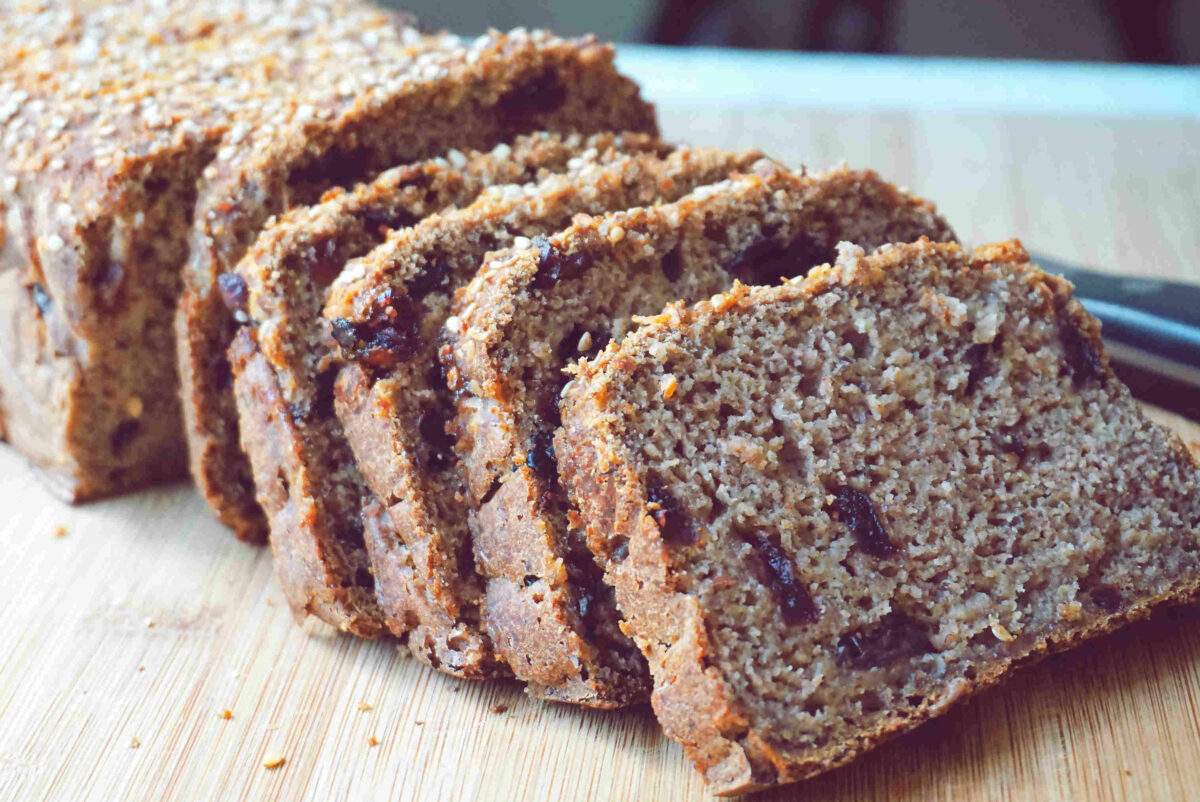


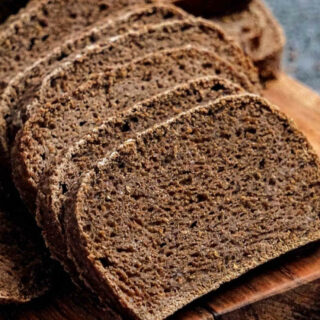
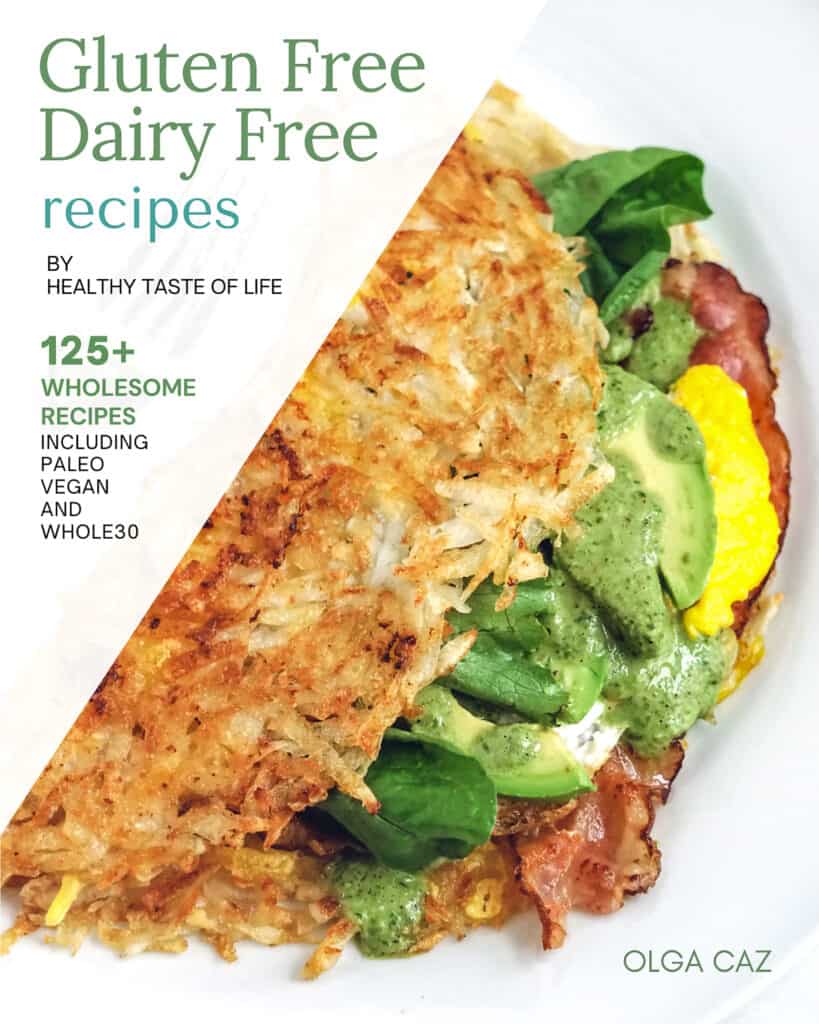
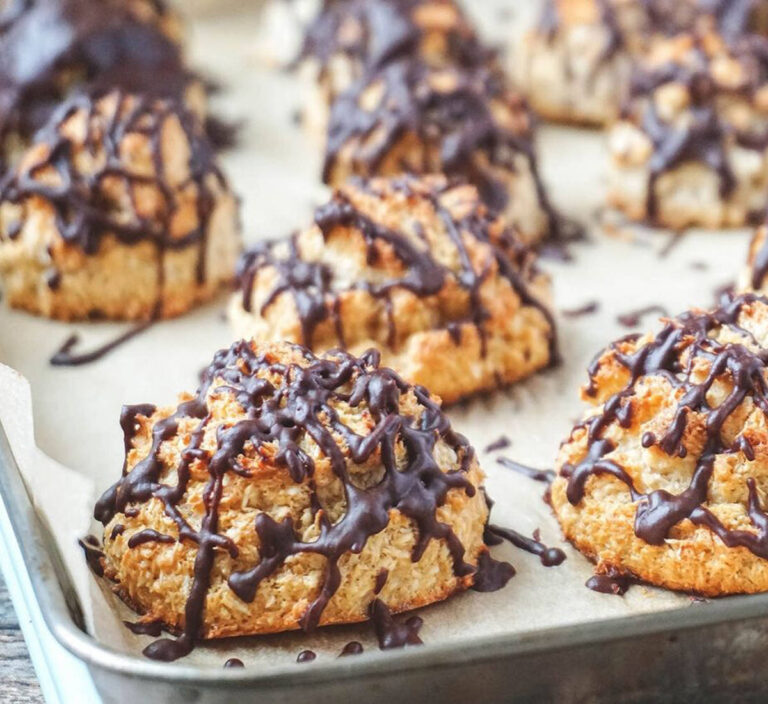
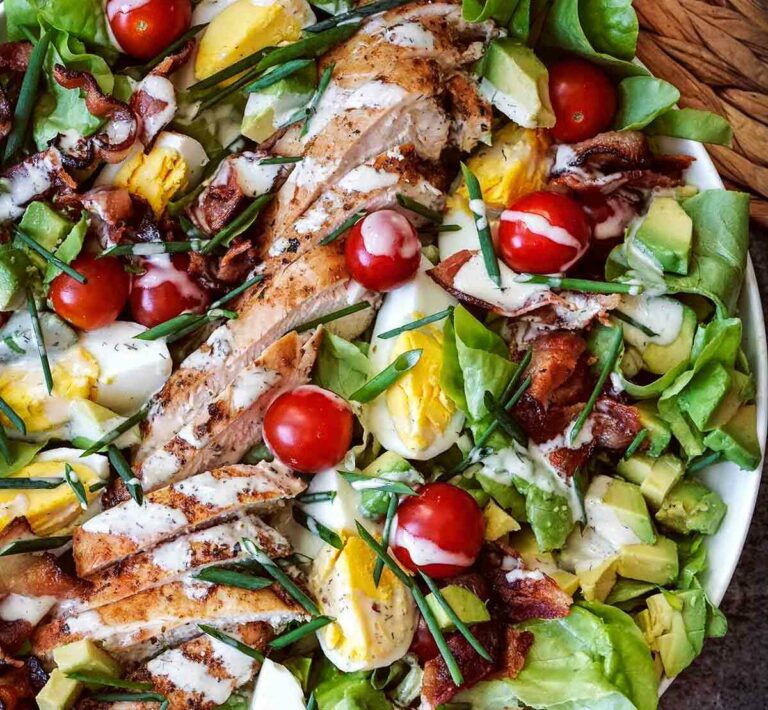

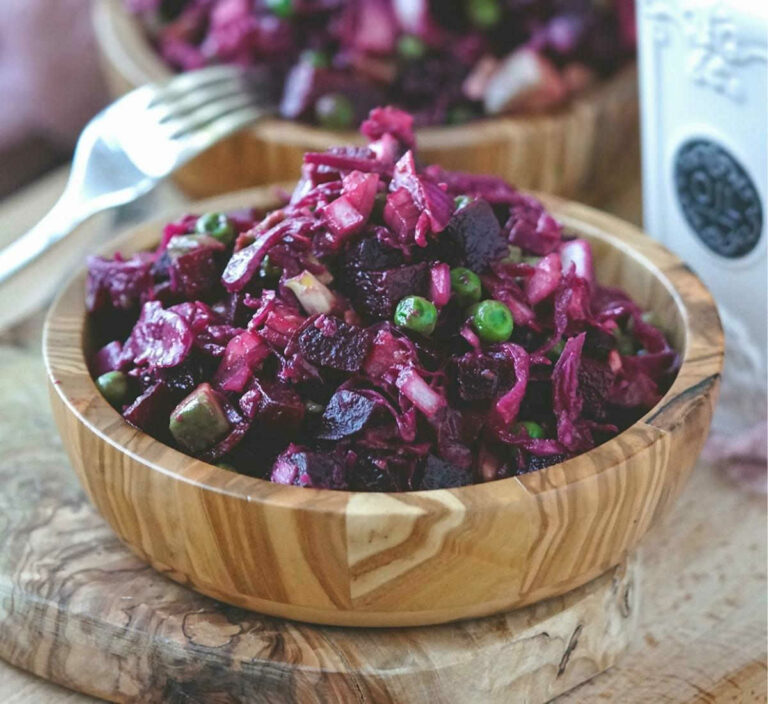
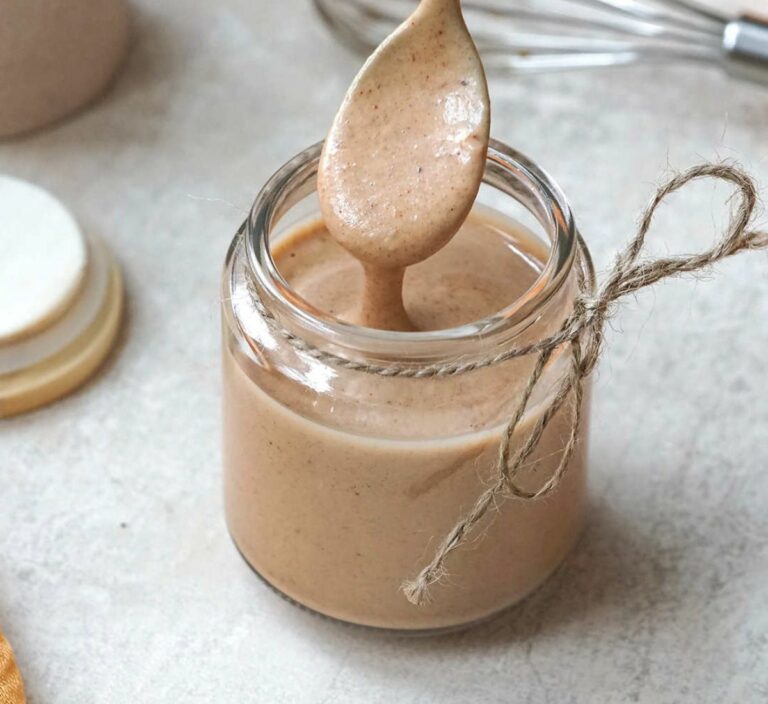

This turned out really nice and light for the first bake. I’m always amazed new recipes for sourdough can be so different. This one being so easy is a keeper. Thank you!
Would it be possible to provide metric equivalents in future recipes? It would be very helpful
Question – I am ready to activate the starter, but the link in step 1 doesn’t seem to be working. Any suggestions? Thank you!
Thank you for telling me about the link, it looks that is not working anymore. Usually when you buy the starter, there is a booklet with details on how to activate it. The starter comes in a dehydrated state, so for activation you basically need the following steps:
1.Pour contents of package into a glass jar (2 quart size) and add ¼ cup water (room temperature) then add ¼ cup gluten free flour, in this case is brown rice flour and stir until everything is combined. Cover with a thin translucent fabric, linen, or cotton or a coffee filter, secure with a rubber band. Place in a warm area, 70°-85°F, for 8-12 hours.
2.After 8-12 hours, feed the starter: mix in ½ cup water and ½ cup brown rice flour. Stir well. Cover and return to the warm spot for 4-8 hours.
3.After 4-8 hours, discard all but ½ cup starter. Mix in ½ cup water and ½ cup brown rice flour; stir and cover. Place the discarded starter in a separate jar and keep it in the fridge covered with a loose lid. You will use it later for baking.
4.Repeat steps 2 and 3 every 4-8 hours, until mixture becomes light and bubbly (about 3 to 7 days, it depends on the temperature and location).
5.Once starter is bubbling within a few hours of being fed, then you can cover tightly and place it in the refrigerator and maintain it by feeding once a week (or once in 10-14 days).
This is a wonderful recipe. I love that it doesn’t contain a lot of unusual ingredients. Thank you so much for sharing it.
Thank you! I tried to make it as natural as possible while keeping a good texture… my daughter also loves it! 🙂
How wide did you extend the pan? It looks longer than the average bread pan. Thanks!
A couple of inches, about 13″ total with extension.